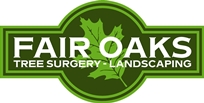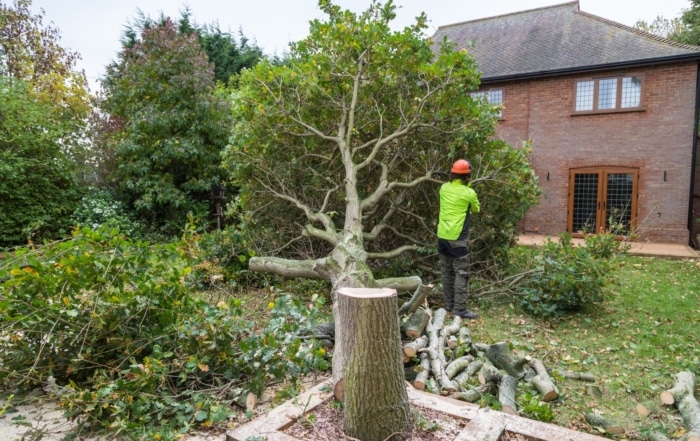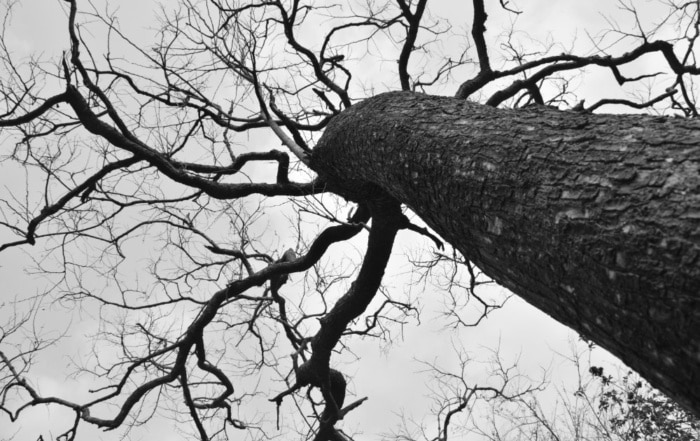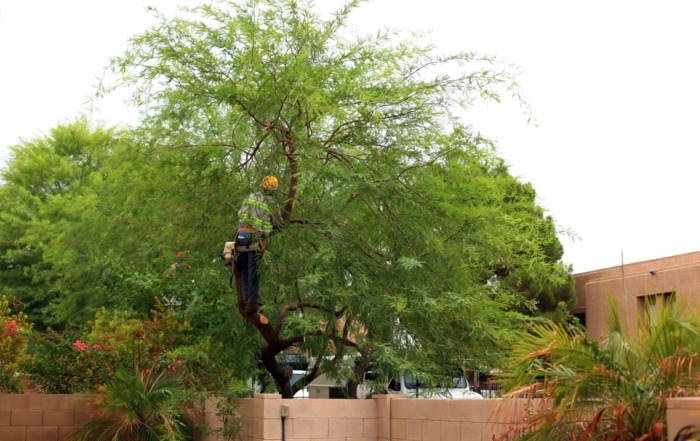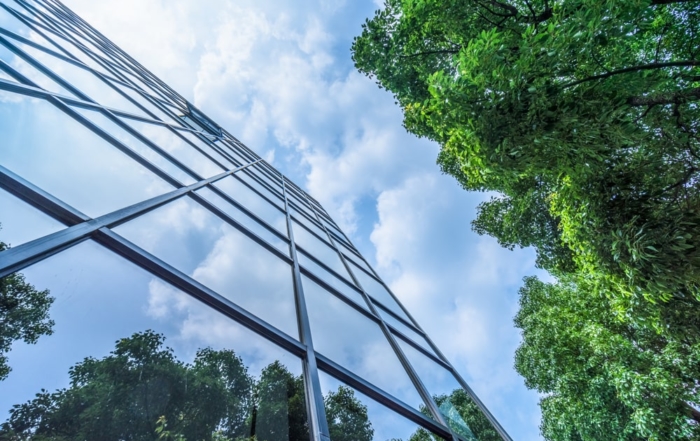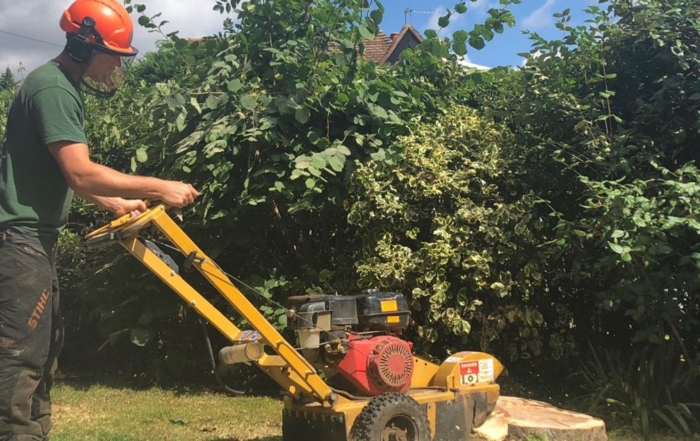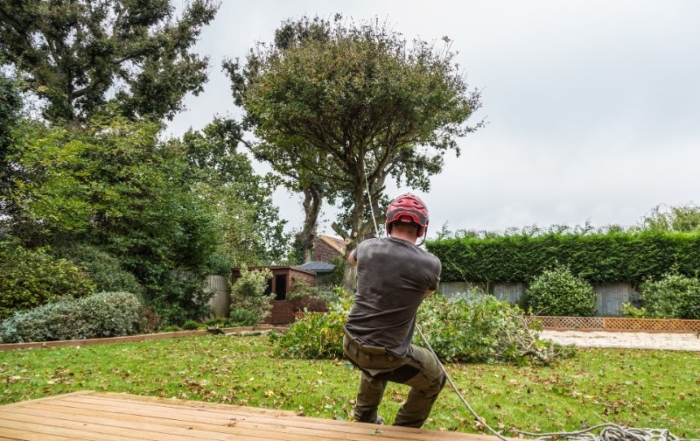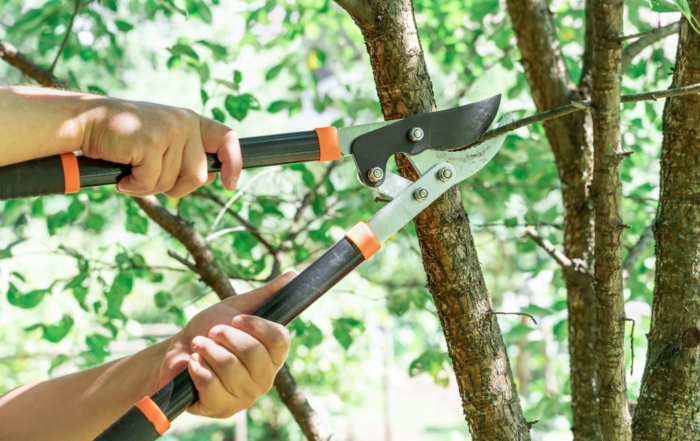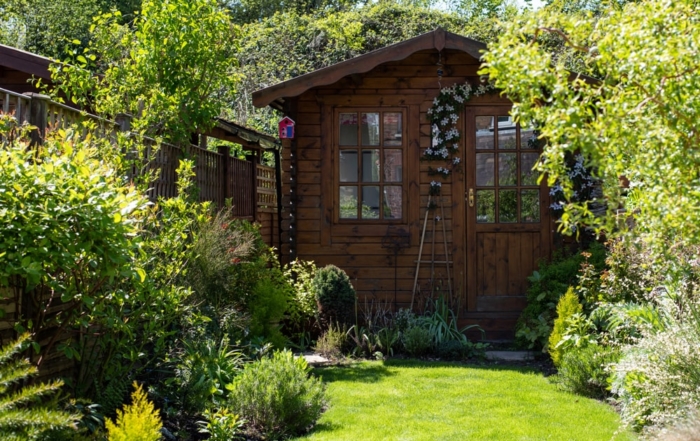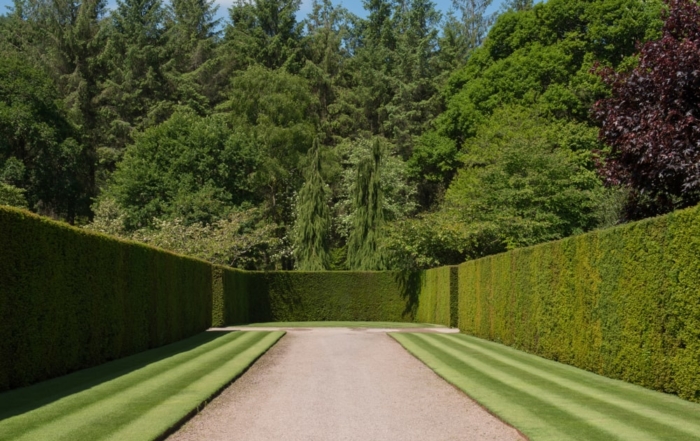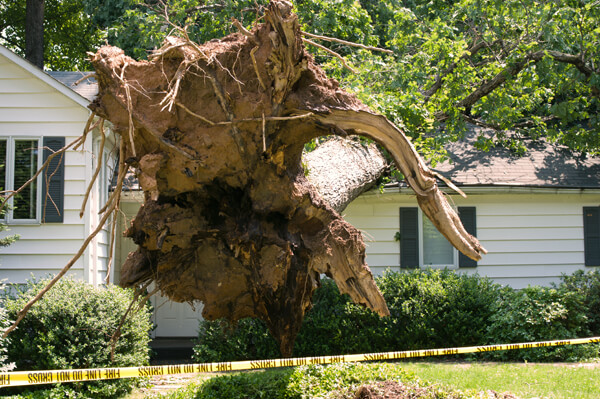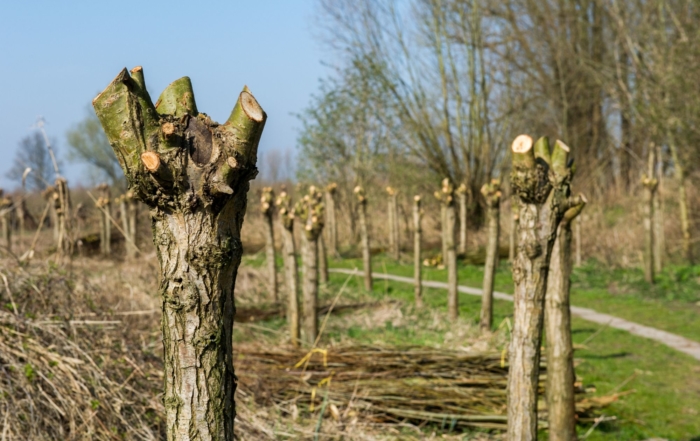Recent News
Straight tree felling vs section tree felling – which is best?
If you have trees causing significant issues or property damage, they may have outgrown the space. Nuisance and dying trees often need removing via tree felling methods, and you may even require emergency tree work if there’s an immediate danger.
There are two main types of tree removal techniques – section felling and straight felling, but which is best? Here’s everything you need to know.
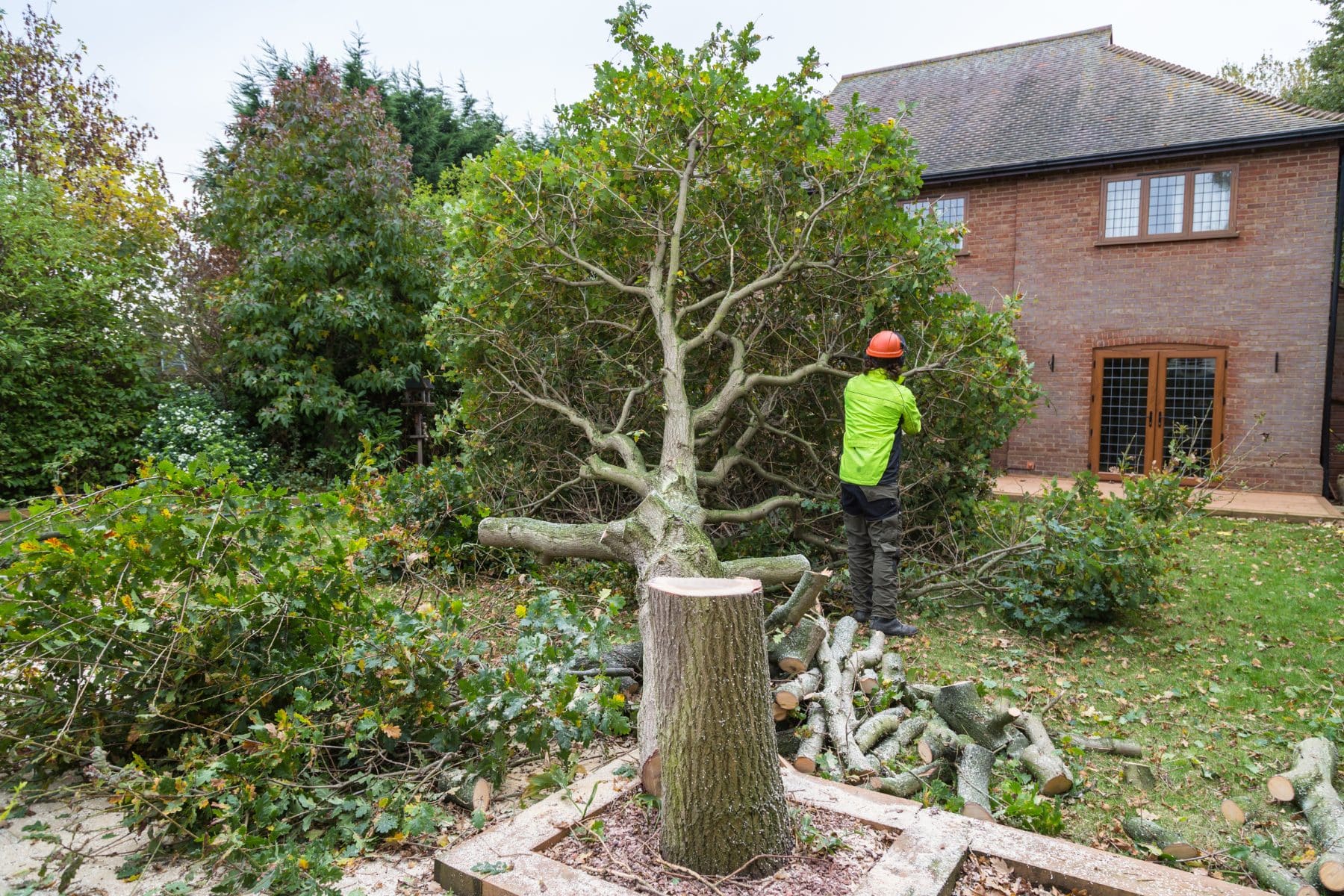
What is straight tree felling?
Straight tree felling involves using cuts to allow the tree to fall in one go. The first cut is created at the base of the trunk to determine the fall direction. Another ‘felling cut’ is then used to ensure the tree falls to the ground in a single motion.
Straight felling can be used if there’s a large unobstructed space around the removal site, allowing the tree to fall without hitting anything around it. Before the procedure begins, the safety of the felling site should always be secured, protecting nearby buildings and people from harm.
The fall will be controlled in such a way that it doesn’t damage the lawn or grounds in which the tree stands. It should only be completed by a trained professional with the right safety equipment, such as ropes and felling wedges.
What is section tree felling?
In tight and restricted spaces, or when dealing with a dangerous tree, section felling is usually chosen. This involves removing a tree piece by piece, methodically lowering different sections to the ground.
During a section felling procedure, a professional tree surgeon will sometimes use a MEWP (Mobile Elevated Work Platform) to reach the highest parts of the tree. This is one of the safest section felling methods. However, for some jobs, a skilled arborist may be harnessed to the tree, lowering each cut section to the ground via specialist rigging equipment.
Which tree felling method is best?
The best tree felling method will depend on each case and its location, which a tree surgeon can assess when they visit the site.
Straight tree felling is often quicker and easier, removing trees more efficiently. This method is sometimes preferred if there’s lots of space around the felling site or several tree removals to carry out.
Section tree felling is the only option if there’s not enough space to safely fell the tree using one cut. It’s also preferred if the structure is unstable, such as when removing decayed trees. Trees in awkward-to-reach spots will also need section felling.
Speak to a tree removal expert
Do you need tree felling services in London and Surrey? At Fair Oaks Tree Services, we offer both straight felling and section felling solutions. We operate throughout the area, coming out to locations such as Kenley, Kingswood and Leatherhead.
For a free, no-obligation tree felling quote, call now on 07780 445079.
Your guide to tree felling disputes
The growth of trees can affect more than one property. While the tree may be based on your land, as it grows larger, branches can cross boundary lines or cause other issues, such as blocking out natural sunlight in a neighbouring garden.
While you may have received a tree felling request or want your neighbour to take action on a tree in their garden, there are some steps to make things easier.
Here are our top tips for resolving tree disputes.
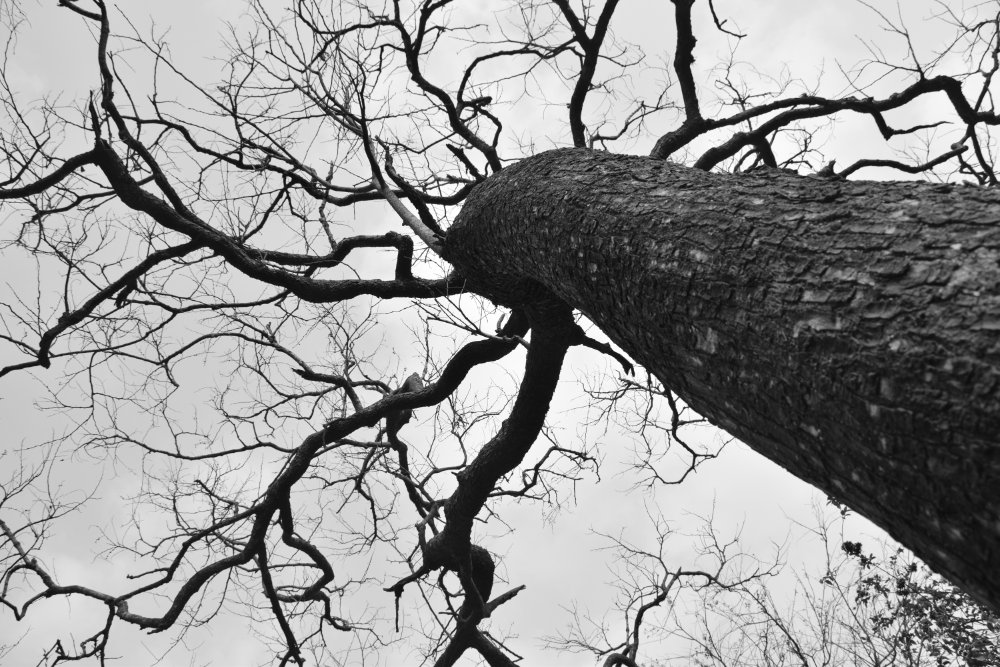
How to solve tree disputes
If you want to cut down a neighbour’s tree or it needs pruning to stop it from being a nuisance, the first thing to do is chat to them or their landlord about the situation. You could even start with a letter if you’re nervous, involving any other neighbours who may also be affected by the issue. However, it’s often easier to have polite, constructive conversations in person, and you may find your neighbour is more than willing to have help maintaining their trees.
If you have no luck by informal means, the next step is to contact your local council. If the hedge or tree problem meets specific criteria, you may have grounds to make a formal complaint. This includes trees that are mostly evergreen, over two metres tall and are affecting your enjoyment of your garden or home. You may need to pay a fee to use this service.
Can you trim a neighbour’s tree?
While you must never remove a tree that’s not on your own land, you may have the right to trim branches that have passed into your property from another space. However, you can only prune the tree or hedge up to your boundary line, or your neighbour could have grounds to take you to court for property damage. The exact boundary between properties is often unclear, so if you’re in any doubt, seek legal advice.
That’s why it’s so important to speak to your neighbour first. They may even be elderly or lack time to trim their trees, welcoming the extra help. If the trees are based in a conservation area or there’s a TPO (tree preservation order) in place, you may need permission from your local council before any work takes place.
Involve an expert tree surgeon
Tree felling disputes often occur when there’s a disagreement about the best course of action. One neighbour will usually want overhanging branches cut back to stop them from infringing on their garden, but the other party involved wants to preserve the condition of the tree.
That’s where involving an expert tree surgeon is the perfect solution. They can assess the tree or hedge and recommend the best pruning methods to keep all parties happy. If a tree is dying or has become unsafe for both properties, they may suggest a complete tree removal.
Get expert tree care advice
Do you need advice from a professional tree surgeon? Speak to Fair Oaks Tree Services. We operate across London and Surrey, including Sutton and Ewell. For more information or a free quote, call now on 07780 445079.
When is a crown reduction required?
Trees can easily become overgrown or unstable if their growth and health aren’t properly managed. Many property owners end up felling trees when options like crown reduction services are available. The aim is that new foliage grows and develops towards the middle of the crown to maintain the natural shape of the tree.
If you’re unsure about when this type of tree pruning solution is needed, here are some of the signs you need a crown reduction.
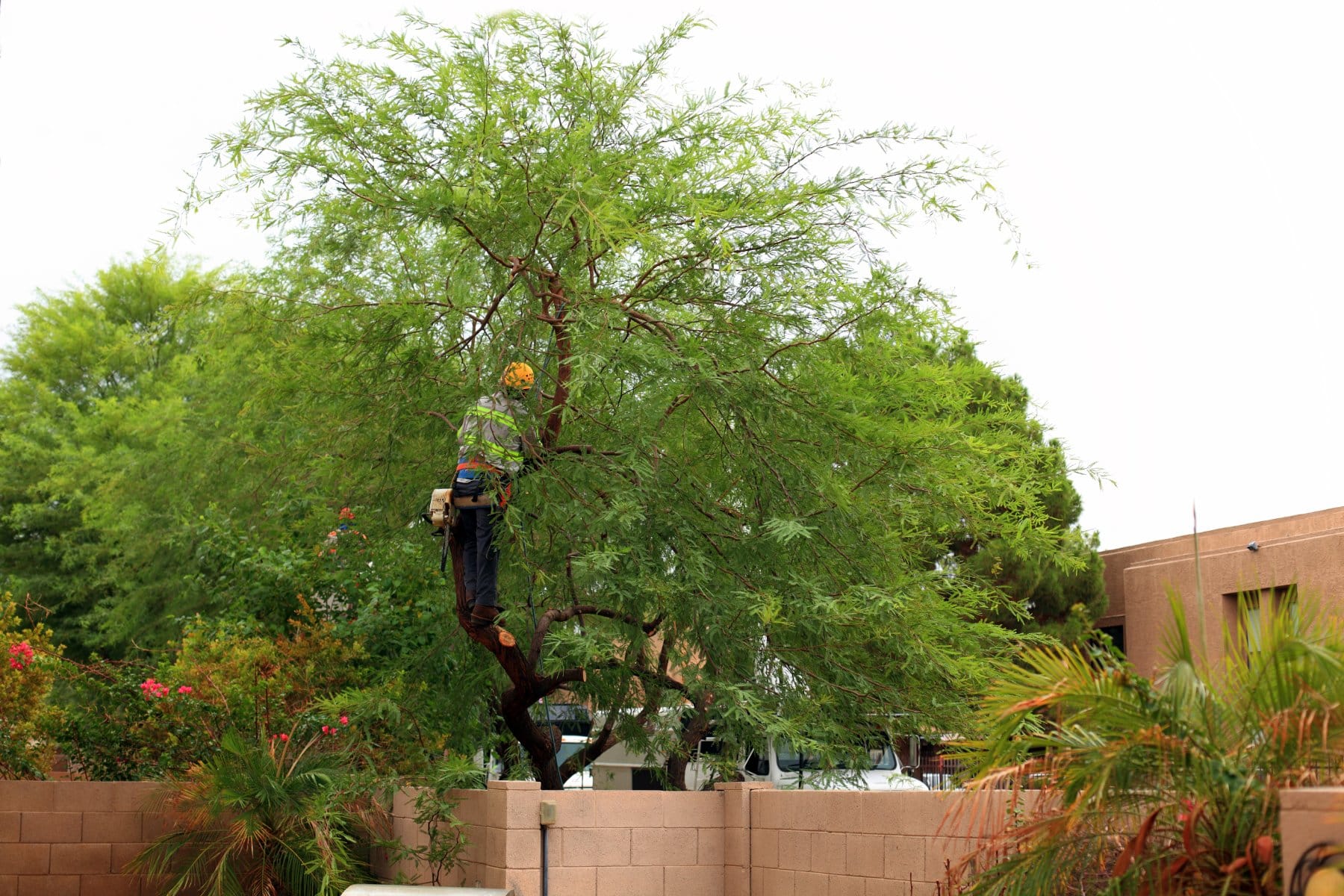
A tree’s height & spread is out of control
While crown reductions are sometimes more drastic than other solutions, it’s one of the best ways to reduce the height and spread of the canopy when it’s grown too large for its surroundings. Reductions are often preferred to topping as the results are more natural in appearance.
However, careful pruning must be applied, so hiring a domestic or commercial tree surgeon is essential. If you don’t use the services of an expert, large pruning wounds could lead to tree decay, and there are certain trees that a reduction isn’t suitable for.
Reductions should never cause unnecessary stress to a tree or create more problems with its future growth, so this service should only be chosen under the right circumstances.
There are lots of decaying tree branches
Crown reductions can improve the health of your trees by removing damaged, diseased or decaying branches. If left untreated, they could break off (especially in stormy weather) and cause damage to nearby buildings or anyone below the tree. Crown reductions may also help keep excessive root growth under control, protecting building foundations.
As well as reducing the risks of falling branches, crown reductions can stop ‘sail’, which can make trees more vulnerable to storm damage. Crown thinning also produces this result using more subtle methods, so ask a tree surgeon to assess your trees to identify the best solution.
It’s the right time of year
Using the services of an expert tree surgeon can reduce damage to trees caused by amateur pruning techniques that worsen the health, growth and stability of the structure. For example, crown reductions are often not a good idea in spring as it can lead to the tree ‘bleeding’ with sap.
A better time of year for a crown reduction is when it’s dying back, helping to promote new growth in targeted areas by removing any deadwood. Your tree surgeon can advise about the best approach, even if it means waiting until another season or choosing a different tree pruning method for the time being.
Get advice from a qualified tree surgeon
Need more advice? At Fair Oaks Tree Services, we specialise in all types of tree care solutions, from crown reductions to stump removals. We work throughout London and Surrey locations, including Banstead and Esher.
For more information or to request a tree assessment, call now on 07780 445079. Alternatively, please message us at info@fairoakstreeservices.co.uk.
Removing trees from commercial sites
When we talk about tree felling, it often refers to projects conducted in a private garden of a domestic residence. However, commercial gardens and outdoor spaces need lots of care and attention too, especially if you’re hosting visitors and guests you want to keep happy.
While tree services should be similar across the board, there are often other considerations for this type of project, including land ownership, safety and reducing business disruptions.
Here’s our guide to removing trees from commercial sites.
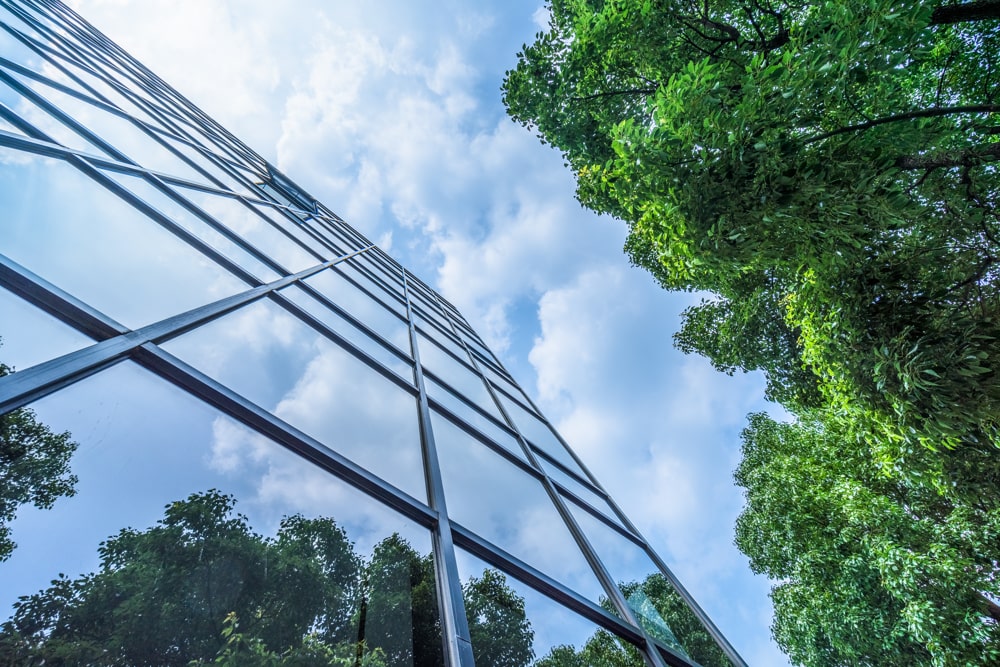
Why remove trees from commercial gardens?
Trees can often be maintained if given the right care throughout the year, but at times, the best solution is to remove a tree or group of plants from an outdoor site. For commercial properties, triggers may include overgrown branches growing towards a building or trees interfering with business communications and signals.
Diseased trees can also be an issue if they’ve become dangerous. Businesses need to be more aware of the safety of their outdoor grounds as it can affect their insurance policies and reputation if their site becomes unsafe. It’s important that trees do not pose a danger to the public, staff and visitors, especially if the structure has become unstable.
You may also need to consider tree felling if you’re planning to expand your premises with further building work.
How to fell a tree at a business site
Tree removals can be noisy work, which is why it’s so important to involve the right experts from day one. A professional tree surgeon is the best point of call, providing advice about aspects such as tree removal permissions (e.g. tree preservation orders) while carrying out a safe tree removal.
They’ll work closely with a business to determine the most appropriate course of action to minimise business disruptions, especially when an outdoor space is accessible to customers, such as hotel grounds or alfresco dining spots.
The tree removal will be completed as efficiently as possible while ensuring the safety of anyone on site is paramount. A systematic approach is taken to ensure the tree is removed quickly, whether straight felling is applied or the tree is cut down section by section.
Should you leave tree stumps in the ground?
A tree stump removal is often best completed at the time of the felling so that it doesn’t become a health and safety hazard or an eyesore.
Once removed, the wood chips can be used to fill the hole, or the ground can be left for development if you have plans for the space. This may include more outdoor seating for your guests or a new feature to enhance the look of your business property’s views.
Get advice from a professional tree surgeon
If you need a tree assessed or removed from a commercial site, get in touch with our team. At Fair Oaks Tree Services, our professional solutions cover a variety of needs. We work across London and Surrey, coming out to Ashtead, Cheam and Epsom.
For free advice and a no-obligation quote, call now on 07780 445079.
Best tree stump removal methods
After a tree removal, the stump will remain in the ground, anchored by the old roots. However, while many leave these stumps in situ, did you know they can also be removed if you’d prefer?
Here’s everything you need to know about the best tree stump removal methods.
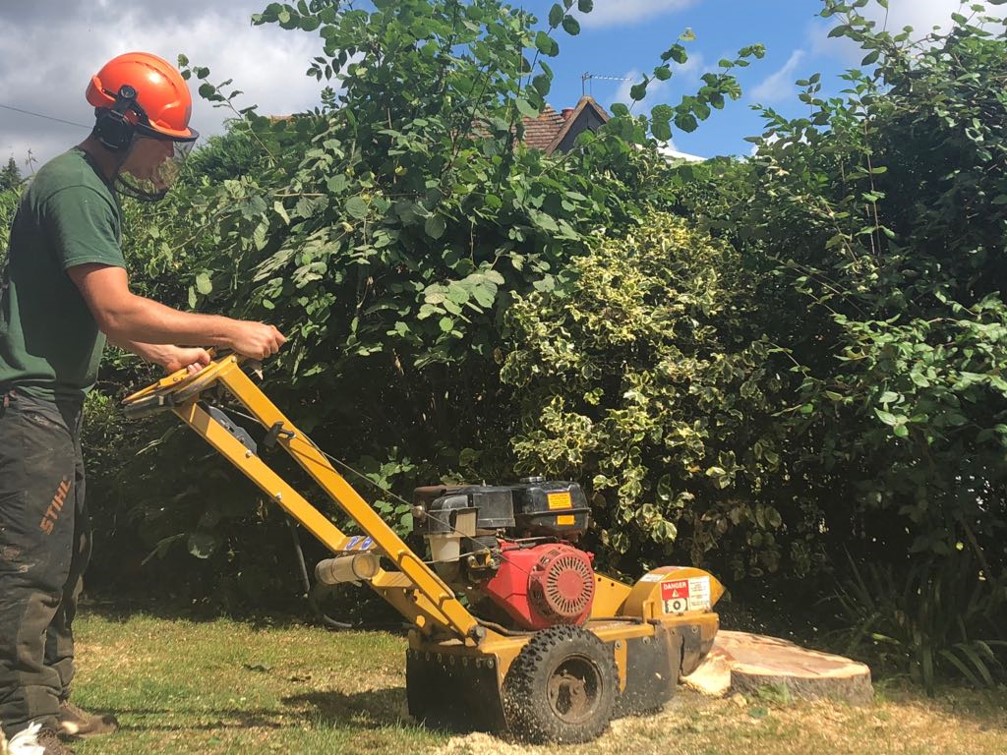
Why remove tree stumps from the ground?
If you’ve felled some trees in your garden, or you’ve moved into a house where stumps have been left in the ground, removing them is a great idea.
One of the benefits of doing this is the additional space it creates, leaving you free to use the area for something else like garden seating. You may even decide to remove your garden tree stumps as part of a new landscaping project.
A decaying tree stump can also be the perfect breeding ground for pests and diseases, and they may look unsightly, tarnishing the appearance of your outdoor space.
Can you remove tree stumps yourself?
Removing a tree stump can be a challenge without having the relevant knowledge and experience. Attempting a DIY stump removal can prove problematic, often resulting in time wasted and the unnecessary destruction of land. You can also cause injury to yourself and others as it’s an incredibly physical job.
Homeowners who attempt DIY tree stump removal methods can spend a lot of money hiring equipment and tools for the job, which are essential if you want effective results. This includes heavy tree stump grinders, which have large circular blades and should never be used without proper training and protective clothing, such as boots, gloves and goggles.
For quick, easy and cost-effective tree stump removals, it’s better to ask a professional to do the job for you.
What happens during a tree stump removal?
There are two types of tree stump removal techniques.
The first method is called tree stump grinding. This is where the remaining stump is shredded using a large power tool. The machine has a rotating cutting disc that grinds up any tree structure left, producing sawdust and chippings that can fill the hole created in the ground. New turf is often laid across the area to create a tidy new space.
The other option for removing tree stumps is chemical herbicide treatments, although this is a longer process and not as environmentally friendly as stump grinding. However, it’s a highly effective way of killing a tree stump, taking up to a month to work, perfect for anyone who doesn’t need garden stumps removed instantly. This method works best on freshly cut trees (i.e. immediately after felling), so it may not be appropriate for older stumps.
Hire professional tree surgeons
Are you looking for a professional tree stump removal? Contact the team at Fair Oaks Tree Services. We offer our tree care solutions across Surrey, London and surrounding locations, coming out to Purley, Wallington and Croydon.
To arrange a free quote, call now on 07780 445079.
What happens during tree felling?
Trees are a hugely beneficial part of our environment, whether they’re planted in a private garden or public area. However, removing a tree is sometimes required if it’s outgrown the space, poses a danger or has become diseased, but it can be hard to know what to expect during the process.
To makes things easier for you, here’s our simple guide to what happens during tree felling.
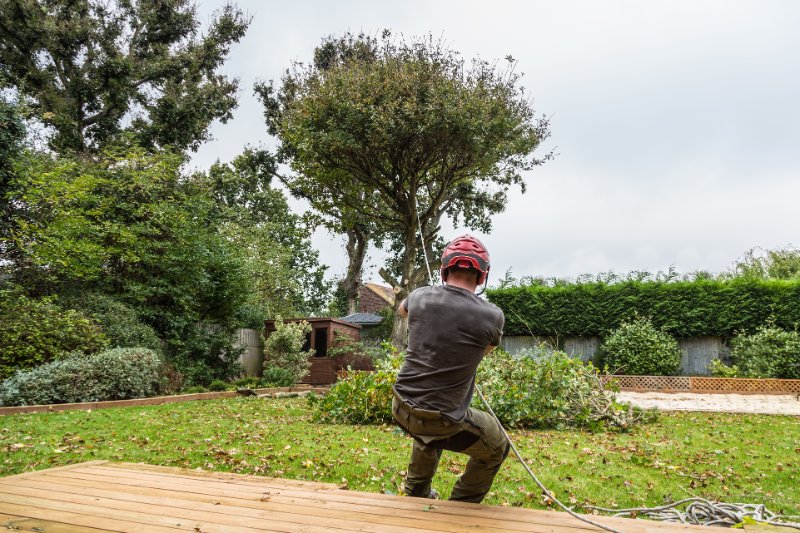
Who can remove a tree?
When it comes to who can remove a tree, it will come down to two main factors – the tree ownership and any restrictions applied, such as tree preservation orders (TPOs). If you live in a rented property, you must get your landlord’s permission first.
While you may have the right to remove overhanging branches coming onto your property, you’re not allowed to fell a tree if it’s based on someone else’s land, such as a neighbour’s property, without their permission. If there’s a TPO in place, you’d have to contact your local authority about why the tree needs removing.
Do you need a tree removal licence?
Tree felling licences are sometimes required if the tree is based outside of a private garden or commercial site. You can check the full list of exemptions on the government website here. If not exempt, it’s an offence to fell a tree without a licence, and this may come with added conditions, such as replanting requirements.
If you’re felling a tree solely within your own garden, always be aware that any damage caused by the tree felling works is your liability.
Should you fell a tree yourself?
The main thing to stress is that DIY tree felling is never a good idea, or you could cause serious harm to others, yourself, neighbouring trees or even your property. You should always use the services of a professional tree surgeon. You could even ask them to check any trees you’re unsure about as part of your summer tree care plans.
During the felling process, professionals will wear protective equipment and secure the surrounding space to ensure the tree removal can be completed as safely as possible.
What are the safest tree felling methods?
The two main tree removal techniques are straight felling and section felling.
Straight tree felling can only occur if there’s a large unobstructed area around the felling site. This involves cutting a notch at the base of the trunk to determine the direction of the fall. This is followed up by a felling cut, and the tree falls, directed to the ground in one go.
However, in smaller spaces or where the tree is hard to reach, section felling is safest. For this method, a skilled arborist is harnessed to the tree, safely cutting down sections so that the tree is removed bit by bit. Each cut section will be carefully lowed to the ground via specialist rigging.
Arrange tree removal services
If you’d like to request tree felling at your property or site, please contact Fair Oaks Tree Services today. We work across Caterham, Woodmansterne and Coulsdon.
For more advice or to book a tree removal, call now on 07780 445079.
Summer tree care tips
As the warmer weather approaches, knowing how to prepare your trees for the high temperatures, low rainfall and sun exposure they face is a must to maintain their health.
Whether it’s large or small garden trees, there are some key things you can do to keep them looking beautiful.
Here are some of our top summer tree care tips to get you started.
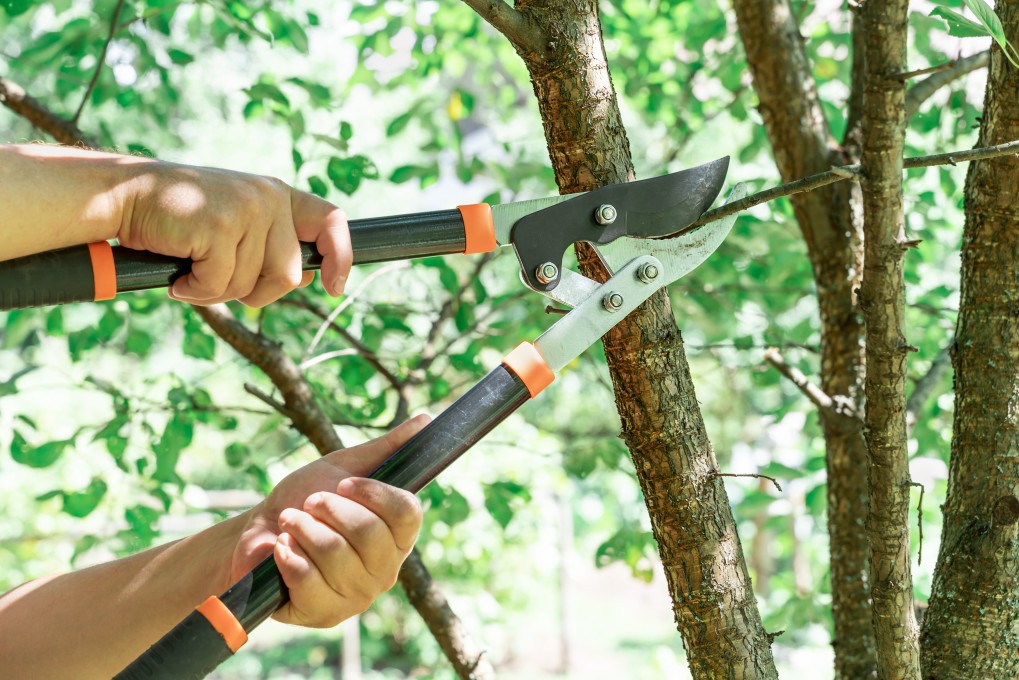
Assess tree health
Summer is a great time to hire an arborist to come and assess the health of your trees. They can advise you about everything from when to prune trees to ways you can promote better growth, as there’s often a delicate balance of tree care tasks, depending on the season.
They’ll also identify if there are any problems brewing, such as decaying branches or dense crowns, which could benefit from thinning services.
Tree watering tips
Unfortunately, many property owners think lawn irrigation will also keep their trees happy, but the water often covers only a few inches of soil.
If you have young trees in your garden, regular watering can encourage healthy root growth from the start. You should also take action if you notice your tree’s health is starting to suffer in dry conditions, including the wilting or discolouration of leaves.
It’s much better to deeply water the area around the tree where feeder roots are located, and you may even want to consider removing grass from around its trunk base. Ask your tree surgeon to show you the best spot to water and how moist the soil should be left.
Conserve moisture via mulching
Once you’ve nailed your watering routine, one of the best ways to conserve moisture is to place mulch around your tree or replenish any already present. This extra layer will help protect the water that’s seeped into the ground below while stabilising soil temperatures.
Mulch should be laid in a several feet radius around the tree (in a doughnut shape), up to around five inches deep. However, try to leave a few inches free between the trunk and mulch to not encourage pests.
What about tree pruning in the summer?
Pruning should always take place at the best time of year to trim each plant, so it’s worth asking a tree surgeon when this should be. Pruning is often preferred during dormant seasons, but this doesn’t mean it shouldn’t take place in the summer if needed.
Conditions that warrant summer tree pruning include the removal of dead, damaged or diseased branches. This will help keep the tree safe and healthy. There are also some tree species that may require trimming once they’ve finished blooming in the earlier months of the summer.
Contact your local tree surgeon
If you’d like to keep your trees strong, healthy and looking good all year round, speak to Fair Oaks Tree Services. Our expert tree surgeons work across London and Surrey, including Leatherhead and Reigate.
For more information and advice, call now on 07780 445079 or email info@fairoakstreeservices.co.uk.
Choosing trees for small gardens
If you’re landscaping your garden, it’s important to choose wisely when it comes to filling the space you have available. If you have a small garden, that doesn’t mean avoiding tree planting altogether but making smart decisions about the varieties you select.
Here are some of the key points to consider when choosing trees for small gardens.
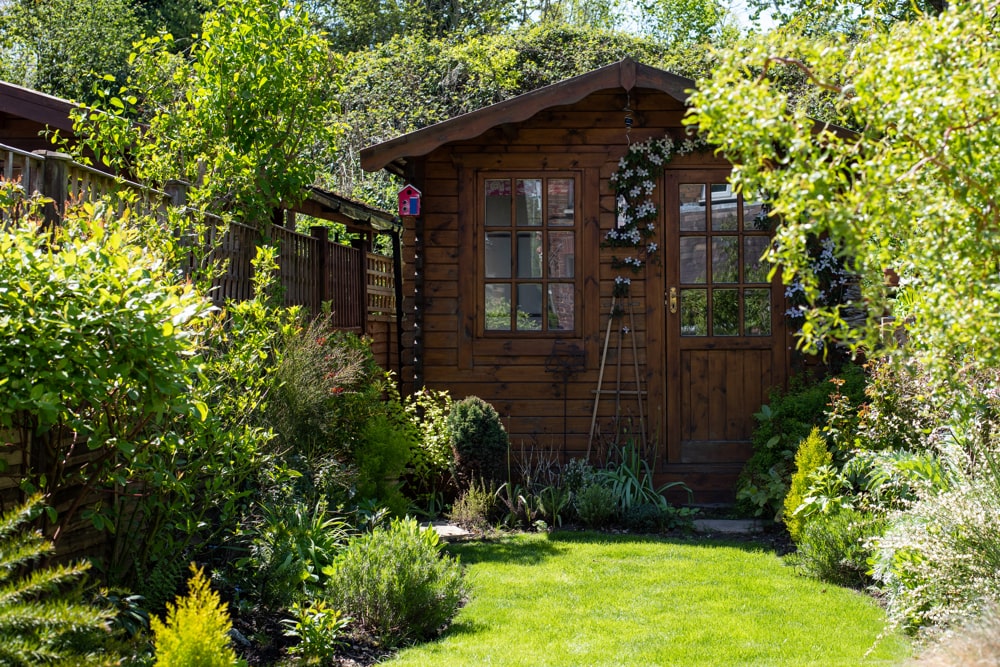
How do you choose trees for small gardens?
The key to getting it right when choosing trees for a small garden is to do your research. It’s not just about how large a tree is when you plant it but how its size may develop over time. For example, a slow-growing tree may work well for a few years, but it can easily become overgrown as time goes on, so this is something you’ll want to avoid.
For small gardens, pick trees that won’t grow too large, don’t block out existing light in the space and aren’t at risk of damaging property foundations with a long root system.
Luckily, there are plenty of options when it comes to small garden trees, including potted plants for your patio. This also allows you to move their position if needed, giving you more flexibility than gardens with large trees growing.
What are the best small trees?
There are lots of beautiful small trees to consider, and one of the most popular options is fruit trees, especially if you’re planting them in a large pot for your terrace, patio or decking area. Popular trees for this type of growth include apple, fig and cherry trees.
Other trees to think about include small acers, hawthorns, evergreens and cercis trees. You could even go for something a little different with a hardy palm tree that’s full of character and will survive in UK weather.
Alternatives to trees – shrubs, hedges & more
In small gardens, trees aren’t the only way to make an impact. An alternative to trees that some homeowners plant along a border is hedges. However, these will be denser than fencing and need to be well maintained so that they don’t infringe upon your outdoor space too much. Regular hedge trimming will manage growth.
You could also consider tall-growing shrubs to create a focal point to view throughout the year. Varieties like viburnums can add colour, depth and height to a garden, as well as providing space for wildlife to enjoy.
Where to get more advice about tree planting
If you’d like more advice about the right trees to plant in your garden, speak to a tree surgeon who also offers garden landscaping services. They’ll have a wealth of knowledge about the best tree varieties for the size of your garden, how the growth will develop over time and the maintenance requirements to keep the tree healthy.
Speak to a tree and garden landscaping expert today
For more advice about all things tree-related, speak to the Fair Oaks Tree Services team. We work across London and Surrey locations, offering tree care and landscaping services in Tadworth, Epsom and Worcester Park.
For free advice, call now on 07780 445079.
A guide to hedge trimming
Like trees, hedges require pruning and maintenance to ensure they look tidy and remain in good health. Hedge trimming should be an essential task in your garden plan, whether it’s a domestic residence or hedges on the grounds of a commercial or public building.
To get you started, here’s everything you need to know about hedge trimming.
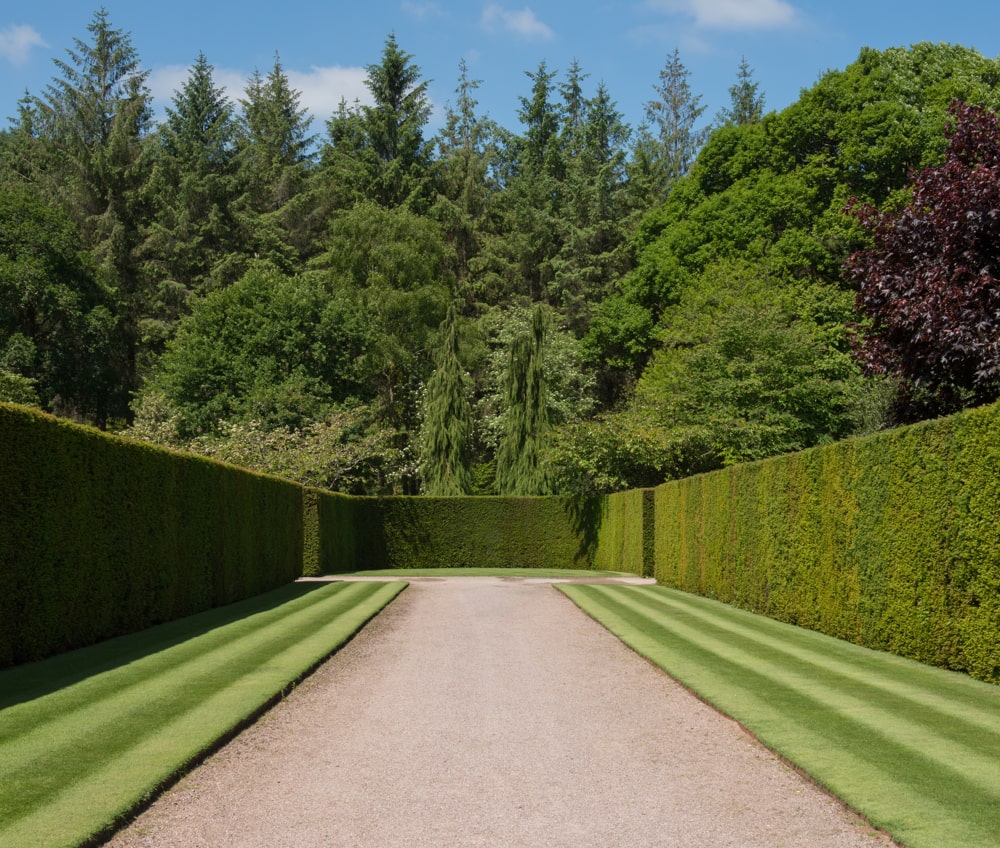
What are the benefits of hedge trimming?
Without proper maintenance, hedges very quickly become overgrown or untidy if they take on an undesired shape. Dense hedges can also block out light from a garden, affecting both your property and the rest of the outdoor space.
A regular hedge pruning schedule is the best way to ensure their size, density and shape remain safe, healthy and aesthetically pleasing. Hedge trimming stops the boundary crossing into someone else’s land, keeps garden borders looking attractive and ensures the shrub doesn’t become too unruly for the space it’s occupying.
You can also produce healthier hedges with regular pruning, helping the foliage and branches to become stronger, improving the shrub’s lifespan and overall appearance. It will even promote healthy fruit growth in some hedge varieties.
When should you trim hedges?
Formative pruning refers to the process of shaping a hedge while it’s young, so this will need completing in the first few years after the shrub has been planted. This aids the hedge in taking on the desired form while it’s new, making it easier to manage and keeping it looking neat for many years.
After this time, hedge trimming will only need carrying out once a year (sometimes twice if the hedge is formal).
The best time of year for hedge pruning will depend on the variety. For example, new evergreen hedges such as conifers should be trimmed in the spring, whereas new deciduous hedges need pruning in the winter months. Maintenance pruning is often completed in the summer.
The timing of hedge trimming will also need to take account of factors such as bird nesting season.
How do you trim a hedge?
There are lots of different hedge pruning techniques, from using large hand-held hedge shears to powered trimmers. However, safety is paramount when undertaking this type of task, so you must consider the equipment required and the heights involved.
Never undertake hedge trimming if you’re unsure about what to do or don’t have the right protection equipment, such as gloves and safety goggles.
You’ll also need to know where to cut the foliage and branches to maintain the shape you want and ensure the growth of the branches doesn’t make the shrub too dense.
The easiest way to keep your hedges healthy is by asking a tree surgeon for help.
Get more hedge pruning advice
If you’d like more advice and help with hedge trimming solutions, speak to the team at Fair Oaks Tree Services. We operate across London and Surrey locations, including Kenley, Ewell and Kingswood. We also offer a wide range of tree surgery services for all your needs.
To contact us, please call 07780 445079 or email info@fairoakstreeservices.co.uk.
Top 3 questions to ask your tree surgeon
Tree surgeons are hired for a multitude of reasons, whether you’re worried about a dying tree or you need professional stump removal services. Whatever the reason for hiring a skilled arborist for help with tree care, it’s always best to go into the situation armed with questions to help you get the most out of the service.
Here are 3 of the top questions to ask your tree surgeon when hiring them for any services offered.
What do I need to know about removing a tree?
Deciding to remove a tree from your garden or land around your property is a big decision, whether it’s because it’s outgrown its spot, been badly storm-damaged, or you have a dying tree on your hands. However, before jumping in and removing trees, you’ll need to consider everything from safe felling methods to respecting TPOs (Tree Preservation Orders) in place.
Follow our expert advice to planning tree removals. (more…)
Benefits of tree pollarding
Having a tree in your garden is not only enjoyable from an aesthetic point of view, but it also contributes to the local ecosystem and will often invite small birds into your garden. It also gives birds of all kinds a place to nest during spring, and serves as an ideal spot to hang feeders all year round.
